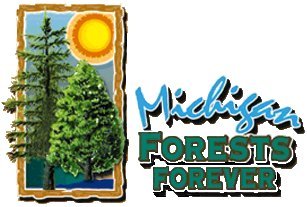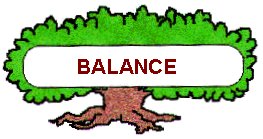

Home Page |
MICHIGAN FORESTS FOREVER TEACHERS GUIDE
| MANAGEMENT SYSTEMS |  |
Selection
Clearcutting
Shelterwood
Regeneration
Plantations
Tree Planting
| Definition
- Silvicultural System: A planned series of treatments for tending,
harvesting, and
re-establishing a stand.
Silviculture: The art and science of controlling the establishment, growth, composition, health, and quality of forests and woodlands to meet the diverse needs and values of landowners and society on a sustainable basis. - Society of American Foresters, 1998 |
There are three main "silvicultural systems" used in Michigan. The names come from the"regeneration method" that is used. Each system has numerous variations.
1) Clearcutting
2) Shelterwood
3) Selection
Each of these systems has two or three main goals.
1) Production of outputs. Timber is
usually a principle output.
2) Establishment of tree regeneration.
3) Improve the quality of the existing stand.
There are a host of other forestry practices that are not part of a silvicultural system. They include practices such as pruning, salvage, wildlife habitat modifications, etc. For more information about "outputs", see the "multiple use" page.
Each silvicultural system produces either an "even-aged stand" or an "uneven-aged stand". Even-aged means that most of the tree ages are +/- 20 percent of the average age. Uneven-aged might mean two or three age classes or an "all-aged" condition where a suite of ages are appropriately represented from seedlings to mature trees.
Silvicultural systems are selected and modified as biological, economic, and social factors are applied. Each can be modified to meet variable sets of objectives. Forest management is flexible but quite intentional, and requires professional evaluation to obtain full benefits from the forest. Generally speaking, better quality sites provide more management options that low quality sites. Northern hardwoods on fertile soils will have many possible management routes. On the other hand, there are not many management alternatives with jack pine growing on a sandy outwash plain, or black spruce in a swamp.
| Activity Suggestion PLT 400 Acre Wood |
| Michigan Forest Type |
Selection | Shelterwood | Clearcutting |
| Northern
Hardwood Aspen Oak-Hickory Swamp Hardwood Cedar Red Pine Jack Pine Balsam Fir Black Spruce Paper Birch White Pine Balm-of-Gilead Tamarack White Spruce |
Yes No Maybe Yes Yes No No No No No Yes No No No |
Yes No Yes Yes Yes Maybe No Maybe No Yes Yes No No Maybe |
Maybe Yes Maybe Yes Maybe Yes Yes Yes Yes Yes Maybe Yes Yes Yes |
| Silvicultural systems are applied based on local conditions, mostly biological characteristics. Shade intolerant types (e.g. aspen, jack pine) must be managed by some form of clearcut in order to secure regeneration. Shade tolerant systems have more options, depending on many considerations. Northern hardwoods are normally managed under a selection system. Also, each forest type typically has a diversity of tree species. Forest types are listed in order of frequency, from the greatest number of acres to the least number of acres. | |||
MSU Extension produced a series of bulletins about forest management and the management of common Michigan forest types.
|
|||
Shade Tolerant Trees
A northern hardwood (sugar maple, basswood, and beech) stand is typically managed under a "selection system", because the constituent tree species are capable of reproducing in partial shade and high quality logs are produced by controlling light conditions. A portion of the trees are harvested with an eye to improving future stand conditions. Near a high-use recreation area, harvest volumes may be lower but the stand entered more frequently. The distribution of harvest might be spread evenly throughout a stand, or may be concentrated on groups of trees producing large "gaps" in the canopy that will encourage regeneration of more light-loving tree species. These "canopy gaps" may also meet certain wildlife habitat objectives. On a poor to medium site (for northern hardwoods) that has difficult and expensive access, the stand might be clearcut and managed on an even-aged basis for lower quality material. The selection system is an uneven-aged silvicultural system.
Special note: Be wary of "select cutting" by non-foresters. This is a common term that masks "high-grading", which is "selecting" the best and leaving the rest .
Trees That Require Full Sunlight
Aspen is an excellent example of a tree species that can only be regenerated under full-light or near full-light conditions. "Clearcutting" provides not only the full light to drive photosynthesis, but also warms the soils and eliminates leaf-origin hormones. These conditions stimulate dormant buds on the parent root systems and aspen suckers may grow in densities of 20-30 thousand per acre (a "typical" mature forest may have 400-600 trees per acre). Longer-lived species in the parent stand might be left to encourage regeneration of other tree species or to maintain certain wildlife habitat features, such as food trees, roost trees, den trees, or shelter from weather. Retaining variable densities of trees within a clearcut might also serve to mimic certain natural processes and improve the visual characteristics of a clearcut. Clearcutting is an even-aged silvicultural system. A "seed tree" system is a variation of clearcutting that leaves a few trees per acre as a seed source. This was typically done with red and white pine but was not a particularly successful method of regeneration. It is no longer a common practice in Michigan. Sometimes, individual red oaks will be left within a stand for acorn (hard mast) production.
Red pine has infrequent seed years and produces limited amounts of viable seed. It requires full sunlight for good growth and is one of the most productive timber species in Michigan. As a result, red pine is often planted after an area has been clearcut, thinned a number of times over the decades, and then eventually clearcut and replanted. This process takes about 60-120 years, depending upon the stand objectives, although red pine might live to be 150-200 years old. This time period is called the "rotation". Alternatively in certain areas, rotations can be extended to provide a more mixed species forest with more old growth characteristics. Such a stand might also be eligible for prescribed burning practices to reduce certain insect problems and stimulate natural red pine regeneration.
Clearcutting often has a bad reputation for two reasons; 1) it has been used improperly, and 2) it has a dramatic visual effect. Nevertheless, it is a valuable silvicultural system and is necessary to maintain a balance in landscape diversity and human needs. For more information about this forestry practice, click here.
Trees With Variable Tolerances of Shade
| HARVEST SYSTEM CONTRAST | ||
| Clearcut
Low |
Factors
Shade
Tolerance |
Selection
High |
Northern red oak and paper birch require lots of sunlight but can tolerate some partial shade, especially during their early years. These species often occur on drier soils, which can impede seedling survival if they become excessively dry. Removing the parent forest (overstory) in stages promotes successful seed germination and seedling establishment under the protective cover of a partial canopy, followed by harvest of the remaining parent forest to provide full sunlight for optimum growth of the next generation. This two or three stage silvicultural system is called a "shelterwood system". It is an even-aged silvicultural system.
Shelterwood differs from the selection system and clearcutting in the number and distribution of trees harvested in the first removal. Generally speaking, more trees are harvested than with a selection system but fewer trees than a clearcut. Enough forest cover is retained to "nurse" the new regeneration of trees but not but threaten it with excessive shade. Most tree species benefit from having the ground "roughed up" to expose many patches mineral soil. Access to the soil is required by many tree species immediately after the seeds germinate. Leaf litter and organic layers can prevent successful regeneration of such species.
A "progressive shelterwood" moves like a wave through a forest, usually in the direction from which the prevailing winds come. Behind the "wave" is new regeneration. In front of the wave is the mature forest. The wave itself, is the forest that has had one or two harvests. The more dense mature forest helps to protect trees in the "wave" from blowing over. Trees that are temporarily retained in a shelterwood are often more windfirm. They may also be more valuable for timber or wildlife reasons and may benefit from a few years of more open-forest conditions.
Tree Regeneration
A forest management system is not good silviculture unless there is a plan for regeneration. In Michigan, natural tree regeneration is not usually a problem. However, obtaining the desired mix of regeneration often requires considerable forethought and expertise. "Natural regeneration" is obtained by creating optimum conditions for trees to reproduce using their own methods. "Artificial regeneration" involves the planting of trees, often preceded by specific site preparation practices.
Most of our forest types are easily regenerated naturally using the silvicultural systems outlined above. That means that we do not have to plant trees for every tree we harvest! At least not in Michigan. Correctly manipulated, nature will produce far more regeneration than planting could ever hope to obtain. Planting is also expensive and difficult work. These resources can be better expended in other ways. Trees regenerate naturally using at least one of three strategies. Seeds are the most obvious strategy. All trees produce seeds, but may use other techniques, sometimes more commonly. Sprouts may grow from stumps after a trees dies or has been harvested. Red oak, red maple, and basswood are typical stump-sprouters. Suckers may grow from parent root systems. Members of the genus Populus (aspens, cottonwood, poplars, balm) usually from dense thickets of sprouts after the parent dies.
Do we plant trees in Michigan? Oh yes! About 30 million trees are planted each year, about three trees for every person in the state. Not all tree species respond well to silvicultural systems. These "difficult" species are usually trees that are highly adapted to catastrophic events such as fires or windstorms, or have peculiar seed production patterns that are difficult to predict and properly time with harvest. The most commonly planted tree species in Michigan is red pine. It is a valuable timber species but is difficult to regenerate naturally. Michigan also plants a lot of white spruce and jack pine. In the Upper Peninsula, a highly production strain of European larch (similar in appearance to our tamarack) has been planted on appropriate sites. Planting may be used to replace an existing stand or to convert one forest type to another. For example a poor quality hardwood stand growing on a pine site may be clearcut, then planted to pine. For more information about tree plantations, click here.
 |
This website was developed and created by Michigan State University Extension for the teachers of the State of Michigan. |